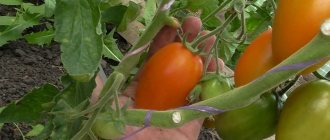Detailed characteristics and description
The carrot variety "Karotel" is very popular among gardeners due to its high yield and excellent taste.
- Appearance. The plant has a rich green part, well branched. There are no stains or brown spots. The root crop is completely immersed in the ground, has a conical shape with a blunt tip. The pulp of the plant is quite sweet and juicy, the color is orange-red. The length of the root crop reaches 9-15 cm.
- What variety does it belong to? Carrot "Karotel" belongs to the mid-early varieties.
- Amount of fructose and beta keratin. The beta-keratin content in one root vegetable is about 10-13%. The fructose level is 6-8%.
- Sowing time. The most favorable time for planting carrots is the period when the air temperature reaches 15°C. As a rule, this is mid-May.
- Seed germination. The seeds of the plant have a high germination rate - about 80%.
- Average weight of one root vegetable. The average weight of Karotel carrots ranges from 80 to 160 g.
- What is the yield? From 1 sq. m of soil yields about 5.6-7.7 kg of carrots. With quality care, this figure increases to 10 kg.
- Purpose of the variety and keeping quality. The variety has excellent keeping quality, which allows you to store these carrots throughout the winter. “Karotel” is suitable for fresh consumption, canning, boiled and fried.
- Growing regions. This carrot variety is suitable for growing in all regions of Russia. The highest yield is observed when the plant is planted in areas with moderate climatic conditions.
- Where is it recommended to grow? The plant is suitable for growing both in greenhouse conditions and in open soil.
- Resistance to diseases and pests . The variety has average resistance to diseases and harmful organisms. To increase this indicator, experienced gardeners harden the seeds.
- Maturing period. From the moment the seeds are planted until the first carrot fruits ripen, about 100-110 days pass. Maybe
Harvest and storage
To ensure that the harvest is ripe, several root crops are removed from the ground. If they have reached varietal size and acquired a reddish-orange color, the vegetables are dug up.
How and when to collect
The crop is harvested on a warm, dry day, approximately 100–110 days after planting. Carrots are dug up with a pitchfork or shovel or carefully pulled out of the ground, holding them by the tops.
Storage features and shelf life
The collected root crops are cleared of soil, the tops are cut off, and dried for 2–12 hours in the sun or under a canopy.
Store carrots in a dark room at an air temperature of 0...+2°C and a humidity of 90–95%. In such conditions, vegetables do not lose their quality all winter.
Reference! To increase shelf life, carrots are placed in boxes, first rolled in a clay mash or sprinkled with a mixture of sand and slaked lime.
Advantages and disadvantages
Among the main advantages of the variety are the following:
- early ripeness;
- fast growth;
- resistance to the main range of carrot diseases;
- high yield rates;
- resistance to fruit cracking and blossoming;
- excellent presentation;
- high content of carotene and vitamins;
- the pulp is juicy, sweet and aromatic;
- possibility of sowing before winter;
- ability for long-term storage.
The disadvantages of the variety have not been identified.
Pests and diseases
According to the description, this variety is relatively resistant to diseases and pests. To increase resistance to weather conditions, it is recommended to harden the seeds. Dangerous pests are:
- Carrot fly. A sign of damage is bronze spots on the top of the plant. Due to late thinning, it manages to lay larvae and infects the entire bed. Damaged root vegetables are unsuitable for food.
- Psyllad. Adults and larvae suck the juices from the petioles of the plant. The plant dries out and dies.
- Carrot moth.
The following diseases are dangerous for the carrot variety Karotel:
- rot (fomoz, dry, white rot);
- brown spot.
To combat pests, the plant is sprayed with chemicals or infusions of garlic, onions, or a decoction of tomato tops. Also, you should not plant carrots close to risk areas, such as coniferous forests.
To avoid diseases, preventive measures are taken - they apply fertilizers to the soil, carefully care for the beds, and carefully select seeds.
Growing
A few days before sowing, the beds are carefully prepared. They are sprinkled with wood ash, and then grooves are created with a depth of 2.5 cm. The optimal distance between the rows is 20 cm, 10 cm away from the edge of the bed. To increase the speed of fruit production, the beds are covered with plastic film.
Before sowing, seeds are also prepared. To do this, they are soaked in water at room temperature for several hours and placed on a moistened cloth until they swell, then the seeds are hardened in the refrigerator on the bottom shelf for 10 days. Before sowing, it is recommended to treat the planting material with insecticides.
Important! Seeds are planted after the air temperature reaches 15°C. Prepared seeds are placed in beds at a distance of 25-60 cm from each other, the depth should be from 0.5 to 2.5 cm.
After sowing, watering is carried out 2-3 times a week, per 1 square meter. m uses about 10 liters of water. Careful attention is then paid to thinning and weeding.
Feed carrots only with mineral fertilizers. The first fertilizing is carried out a few weeks after the appearance of mass shoots.
Agricultural technology
The variety is grown by direct sowing of seeds into the ground. Before sowing, seed material is prepared in the usual way. Place the garden bed in a well-lit area. The best predecessors are cucumber, tomato, cabbage, and peas. A few days before sowing, remove plant debris and dig up the soil to the depth of a shovel. Since the seeds are small, their planting depth is small - about 2 cm. Seed sowing rate: 3 - 4 grams per square meter. The distance between the grooves is up to 20 cm. Planting density is 120 - 1150 plants per square meter. After the emergence of full shoots, it is necessary to thin out so that the density does not interfere with the normal development of the underground part of the plants. Watering is carried out once every 7 - 10 days. After moistening, you should carefully loosen the soil to destroy the formed soil crust.
Sowing carrots can be done in the spring - March - April, depending on the region. If frosts are predicted on the soil, then the bed can be hidden under any covering material that allows air to pass through. The minimum temperature for seed germination is 4 - 6 °C, the optimum is 18 - 25 °C. To obtain an early harvest in the southern regions and the middle zone, pre-winter sowing is carried out in October - November with dry seeds. In this case, seed consumption is expected to be slightly greater than for spring planting.
Karotel is a proven and successful variety for cultivation in all regions of Russia. The culture is unpretentious, but productive. The excellent taste allows you to consume this vitamin product in its natural form. Root vegetables are also well suited for processing and canning vegetables. Features with a plus sign are long-lasting shelf life, resistance to bolting, discoloration and cracking. The increased content of carotene and vitamins makes the variety healthy.
Various problems during cultivation and ways to solve them
There are several problems that may arise when growing Karotel carrots:
- Rot. Root vegetables have an unpleasant odor and are not suitable for consumption. To eliminate this problem, a month before harvest, the plant is treated with Bordeaux mixture. In order to prevent such damage, it is worth abandoning the use of nitrogen fertilizers and treating the seeds before sowing.
- Cracking of fruits. Such root vegetables look unappetizing and have a short shelf life. To eliminate the problem, sapropel is added to the soil or the acidity of the soil is reduced by liming.
- Shape deformation. The problem can no longer be solved, but it can be prevented by following the rules of agricultural technology.
There are many varieties of carrots. The timing of sowing and ripening is different for everyone. The taste and cultivation methods also differ. We invite you to learn a lot of useful information about different varieties of this tasty and healthy root vegetable. Read about these - Nandrin, Samson, Nantes 4, Forto, Champion, Laguna, Losinoostrovskaya 13, Red Giant, Boltex and Abaco.
Transitional varieties of carrots
This includes three carrot varieties: Berlicum/Nantes, Flakke/Carotinnaya and Chantenay/Danvers. The first one is very popular in Russia, but the other two are little known.
“Berlicum/Nantes” carrots have blunt-nosed, cylindrical roots that are longer and thicker than the “Nantes” varieties.
In addition, carrots from this group performed well in long-term storage. According to the timing of ripening, it can be either early or mid-ripening. This type includes the following varieties of carrots: Nandrin, Baltimore F1, Baby F1, Losinoostrovskaya 13, NIIOH 336, Vitamin 6. Flakke/Carotinnaya carrots , as is clear from its name, contain a record amount of carotene. Its fruits are thin, spindle-shaped, and nothing more is known about it. These include varieties “Varvara” and “Golden Autumn”.
The “Chantenay/Danvers” carrot is short and thick, just like the regular “Chantenay”, but its nose is not blunt, but sharp.
This variety includes the “Canada” variety. We hope that you were able to understand the variety of carrot varieties and choose the best options for yourself for the next summer season.
We wish you success and great harvests!
Similar varieties
Among the types of carrots similar to “Karotel”, the following are distinguished:
- Alyonka. It has the same high resistance to diseases and pests. Contains almost the same amount of beta keratin.
- Children's sweetness. The variety has the same high yield, the indicators are almost identical.
- Queen of Autumn. They have a similar appearance and identical ripening time.
Carrotel “Karotel” is a variety that requires constant attention, for which it thanks for its beautiful and tasty fruits. The variety is often used for industrial breeding.
If you find an error, please select a piece of text and press Ctrl+Enter.
Reviews of carrots “Karotel”
This is my review of Karotel carrots. I have been growing this variety at my dacha for several years. I came across it by chance, the seed seller recommended it.
Having sowed it and harvested the first harvest, I was pleased with the result. The “Karotel” variety is very popular for cultivation in central Russia, where summers are not always hot and sunny. This carrot is unpretentious in care and is resistant to various types of diseases and is not afraid of pests. Carrots are large and juicy; they are perfectly stored in winter without losing their juiciness and sweetish taste.
By following simple rules for sowing and caring for this core crop, you will achieve high yields.










